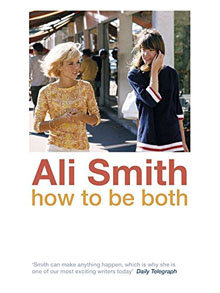 How to be both is Ali Smith’s sixth novel and her third to be shortlisted for the Man Booker Prize. As is typical of Smith, she pushes the novel form to its limits with humorous invention. She shifts from past to present with gusto and is almost dizzying in her linguistic sense of play.
How to be both is Ali Smith’s sixth novel and her third to be shortlisted for the Man Booker Prize. As is typical of Smith, she pushes the novel form to its limits with humorous invention. She shifts from past to present with gusto and is almost dizzying in her linguistic sense of play.
The novel is a story of two halves. One section follows the contemporary narrative of teenage girl George, whose mother, Carol, has recently died as a result of a freak allergic reaction. The other section is voiced by Francesco del Cossa, a fifteenth century fresco painter from Italy. Half the books were printed with George’s narrative first and the other half with del Cossa’s. So, from the get go, the story you encounter is somewhat down to chance. Unsurprisingly, one of the themes that runs through both stories is that of luck.
Shortly before her death Carol, an economist and political artist, took George to view the Palazzo Schifanoia in Ferrara where some of del Cossa’s finest works are to be found. Written in free and indirect style, George grieves for her mother through a series of invented rituals while remembering the time she spent with her. One of her rituals involves repeatedly viewing a pornographic video of an older man with a child. Another has George observing a woman, who may have been her mother’s lover or a spy, outside her house for hours at a time. Yet another finds George endlessly viewing del Cossa’s portrait of St Vincent Ferrer in the National Gallery. The nature of looking is of particular importance here. The power of observation, what it is to be watched, the transformative nature of art, the importance of perspective, what and how one chooses to be perceived are all explored through a narrative that forces the reader to reconsider the traditional conventions of time.
Smith evokes del Cossa as a woman passing for a man in order that she could become an artist. Her first person account has her recalling her upbringing, then her training and subsequent working life as painter. Her voice, perhaps spectral or possibly imagined by George, narrates her remembrances. She follows the grieving George from the National Gallery and beyond, trapped in a twenty-first century ‘purgatorium’. There are some funny observations made by del Cossa. The ‘votives’ and ‘tablets’ that people carry, hold up and speak into and the ‘squee of a mosquito that comes through the little confessional grille’ that George listens to as she dances, show us that the differences between the centuries are both huge and minimal. Smith’s love of the English language is also evident as she harnesses its mutability, structurally and thematically, to traverse the bounds of time, gender and form.
There is much that stalwart Smith fans will recognise. Indeed, legacies from previous stories, like ‘Writ’ from The First Person and Other Stories, live on here. In ‘Writ’ a woman argues with her younger self about the meaning of the titular word, after which the two selves bond through their shared tastes in pop music. George and her mother disagree over the lyrics to a Pet Shop Boys song, and Mrs Rock, George’s school counsellor, gives her a lesson on the etymology of the word ‘mystery’. George meditates on the past beneath our feet, the ‘nondescript town buildings that people are living and working in right now with no idea that the bones are there below them.’ In ‘Writ’ the narrator muses about the ancient corpses buried beneath the common centuries ago. Smith carries on the conversation she is having with herself about the layered nature of the past and how it lives into the present. How language evolves over time and the stories that can be found in the histories of words.
There are similar references to other parts of Smith’s back catalogue and at times the writing feels intentionally self-conscious, like when George describes her experience of viewing the frescoes:
It is like everything is in layers. Things happen right at the front of the pictures and at the same time they continue happening, both separately and connectedly, behind, and behind that, and again behind that, like you can see in perspective for miles.
Smith isn’t just compelled to invent stories, but she is also working at telling an understanding of their function. She has the feel of a writer at the top of her game. In telling a thoroughly inventive story about a contemporary grieving girl and an imagined version of a historical figure, she also asserts her vision for the novel as a form. She shows us what stories are, why we have always needed them and why we will continue to do so. Smith has been described as an heir to Woolf on more than one occasion. Her vibrant sense of linguistic play, her command of rhythm and the lyric all show us that she is, indeed, in dialogue with the modernist project. Essentially, Smith shows us that stories voice and realise what it is to be. To be male, female, past, present, happy, sad etc. Smith’s writing drips with the vitality of being. And not only does it feel important, it is also highly entertaining.











